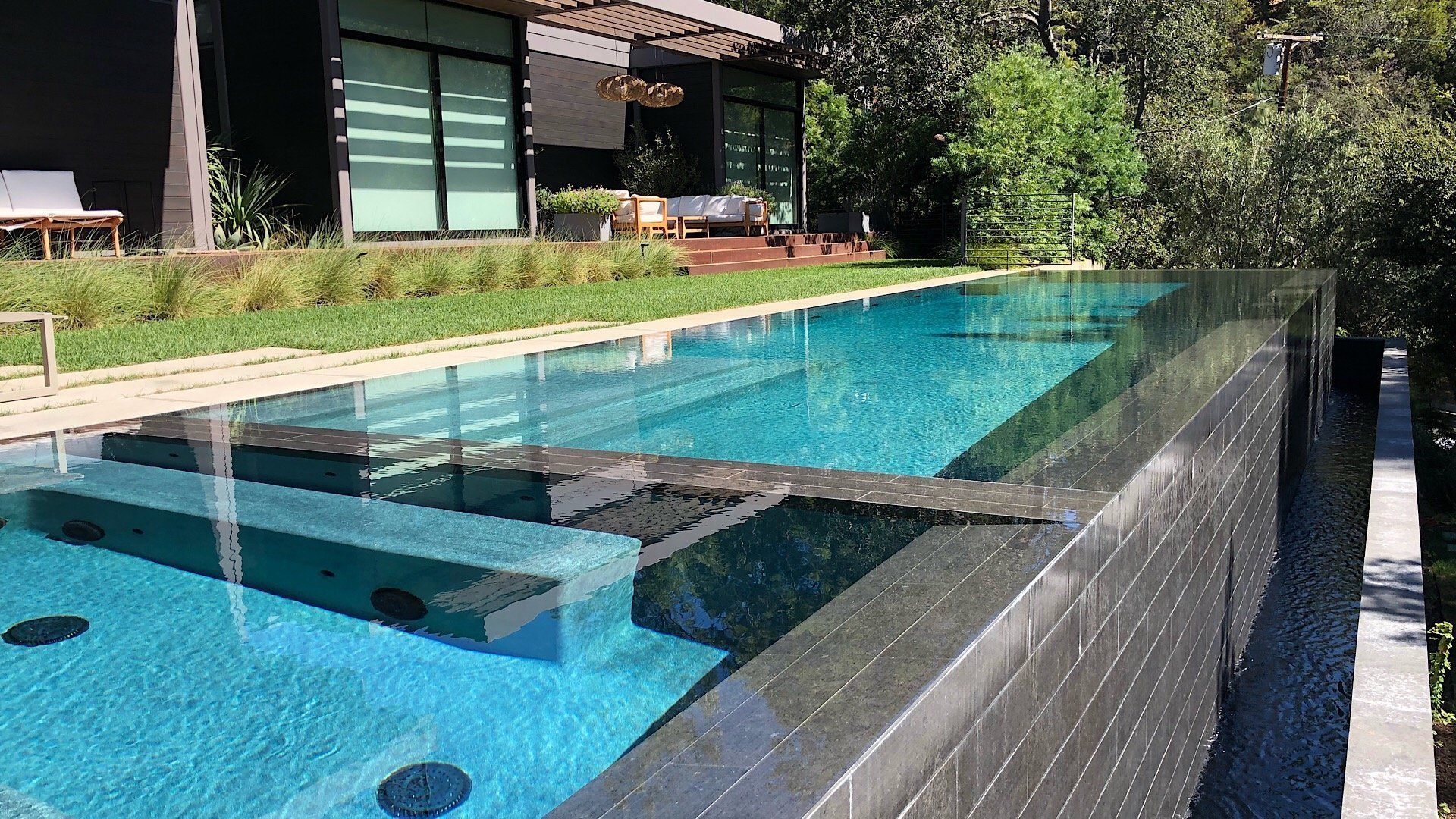OZONE VS. SALT POOLS
Ozone vs. Salt Pools
In recent years, the use of pools with salt chlorine generators, rather than chlorine tablets, has been on the rise. In salt chlorine pools, a generator is used to convert salt in the water to chlorine. These pools are both convenient and safe, making them an optimal choice for personal swimming pools. Both ozone and salt pools have their benefits.
The Benefits of Ozone and Salt Pools
For water treatment, both ozone and salt pools share similar benefits that would easily make either one a preferable choice over chlorine treatment. These benefits include:
- No chemicals that could pose a danger to health
- Do not include more than trace amounts of chloramines
- Skin and eyes are not irritated by the water
- Water feels softer, which makes for a more comfortable experience
- Automatically decontaminated and oxidized pool water
Disadvantages of Saltwater Pools
However, replacing a chlorinated pool with a saltwater pool has not been advantageous for all. Many owners of pools with salt generators have reported the appearance of abnormal stains and discolored water. Many have been unable to eradicate these stains or stop them from appearing again.
Specific examples of blemishes found in various pools have included brown or black rings on and around ladders, dark specks on the floor of the pool, discoloration or stains around railings and steps, purple or brown coloring of water, and unidentified particles in the water. Pool owners are unable to clean the stains and cannot explain where they came from.
Disadvantages of Saltwater Pools
While these discolorations seem inexplicable to many, there is in fact a very simple explanation for them. The stains in salt generator pools are the result of a process known as galvanic corrosion. This electrochemical reaction can only be fully explained after an understanding of salt chlorine generator technology is gained. Additionally, the reaction only occurs in water with a high level of total dissolved solids (TDS).
A process known as electrolysis is essential to the functioning of a chlorine generator. It is a chemical decomposition that is brought about through the use of electricity, passed through a solution of liquid and ions, in this case water and chlorine ions. As natural salt found in the oceans is composed of sodium and chlorine (NaCl), chlorine ions are an innate component of salt.
Since electrolysis is a decomposition reaction, it breaks down NaCl into its smaller parts, sodium and chloride, thus generating new chemical products. A salt generator conducts the process of electrolysis by passing an electric current through the pool water containing sodium chloride. The chlorine produced is then used to keep the pool clean and free of contaminants.
Although there are many different types of salt chlorine generators, the most commonly used in swimming pools is the in-line generator. In this particular style of saltwater generator, there are electrochemical cells made of titanium. There is also a circulation mechanism, so all the water in the pool is periodically passed over the cells. When the water with salt come into contact with the electric cells, it is converted to sodium and chloride ions, providing chlorine to sanitize the pool water.
History of Electrolysis
While these discolorations seem inexplicable to many, there is in fact a very simple explanation for them. The stains in salt generator pools are the result of a process known as galvanic corrosion. This electrochemical reaction can only be fully explained after an understanding of salt chlorine generator technology is gained. Additionally, the reaction only occurs in water with a high level of total dissolved solids (TDS).
A process known as electrolysis is essential to the functioning of a chlorine generator. It is a chemical decomposition that is brought about through the use of electricity, passed through a solution of liquid and ions, in this case water and chlorine ions. As natural salt found in the oceans is composed of sodium and chlorine (NaCl), chlorine ions are an innate component of salt.
Since electrolysis is a decomposition reaction, it breaks down NaCl into its smaller parts, sodium and chloride, thus generating new chemical products. A salt generator conducts the process of electrolysis by passing an electric current through the pool water containing sodium chloride. The chlorine produced is then used to keep the pool clean and free of contaminants.
Although there are many different types of salt chlorine generators, the most commonly used in swimming pools is the in-line generator. In this particular style of saltwater generator, there are electrochemical cells made of titanium. There is also a circulation mechanism, so all the water in the pool is periodically passed over the cells. When the water with salt come into contact with the electric cells, it is converted to sodium and chloride ions, providing chlorine to sanitize the pool water.
Galvanic Corrosion in Swimming Pools
Now the chemical processes of galvanic corrosion and electrolysis are clear, but you may still be wondering: how exactly does galvanic corrosion occur in saltwater pools?
Pools cleaned by a saltwater chlorine generator often have high levels of total dissolved solids (TDS). When there are opposing metals in that TDS solution, the groundwork for galvanic corrosion has been laid. The term opposing metals refers to cathodic and anodic metals. Cathodic metals tend to take electrons and anodic metals give electrons, so in galvanic corrosion there is a flow of electrons from one type of metal to another.
The process of galvanic corrosion can take place if and only if three major conditions are met. First, there must be opposing metals present in the solution. Second, the anodic and cathodic metals must be in contact electrically (in the same solution). Third, there has to be some sort of salt in the solution, so that the dissimilar metals are exposed to an electrolyte.
Saltwater pools with high TDS meet all three of these conditions. Titanium is the main material used for most electrochemical cells, and copper is utilized in the heat exchanger, brass pipes, and other metal components of the pool system. If you refer back to the Galvanic Corrosion Chart, you can see that titanium is a cathodic metal, while copper is relatively anodic. The combination of the two poses a high risk of galvanic corrosion.
In pools with a saltwater chlorine generator, copper corrodes through the process of electrolysis, made possible by the salt or electrolyte content of the water. This corrosion of copper accounts for the various stains and discolorations found in saltwater pools. When it corrodes, copper is a dark brown or black. When insoluble copper is present in water, it appears green, but when the pH of the solution is low enough to produce cyanuirc acid (copper cyanurate), a purple color is produced in the water.
The Salt Solution
Fortunately there is an easy method to solve the problem of corrosion in your saltwater pool. The basic idea to stop copper from corroding is to add another anodic metal to the solution that will corrode instead of copper, but will not leave any stains. One example of an anode such as this is zinc.
Since zinc is extremely low on the Galvanic Corrosion Chart, significantly lower that copper, titanium will cause zinc to corrode instead of copper through an electrolysis reaction. Thus, the corrosion of copper will be greatly decreased. When zinc corrodes, it does not leave any staining and is safe for human contact.
Zinc can be added to swimming pools by putting the solid form of the metal in the circulation system or pool skimmer. In addition to adding zinc, you should use a metal remover to extract the corroded copper that is already present in your pool. Zinc can be used as a preventative measure, but not to clean the present stains and discoloration. It is crucial to be discerning when choosing a metal remover. Many of these products include phosphate, which will likely make the stain problem worse and cause difficulties with the generator. Thus, a phosphate-free metal remover should be utilized.
Zinc will also prevent the purple coloring in the water. However, an additional step must be taken to completely remove and block the cyanuric acid from reappearing. The pH of the water must be increased, making it less acidic, and cyanuric acid should be lowered down to a level of approximately 35 parts-per-million. By following these techniques precisely, you should be able to clean the stains out of your pool in no time, and prevent the discoloration from ever reappearing!
The Ozone Solution
The only disadvantage to ozone is that the effect is diminished in hotter temperatures. This is easily solved by using a subtle amount of chlorine in the dead spots where the water doesn't circulate. This helps the pool so that algae is unable to grow and ozone does all the heavy lifting of being the primary sanitizer
Ozone is quickly becoming the preferred sanitation choice for being the simplest. Other practices don't compare to the wowing effect that ozone gives to the appearance of the pools. Using a contact tank that allows more oxygen contact time is what gives the water a smooth clean surface from reducing the amount of bubbles. Overall, ozone is the preferred choice for any pool.




